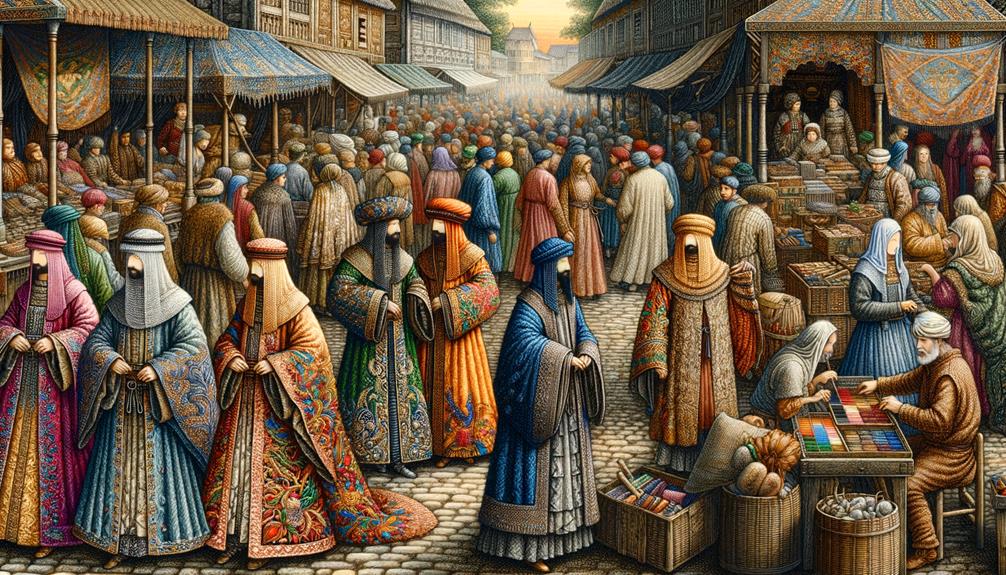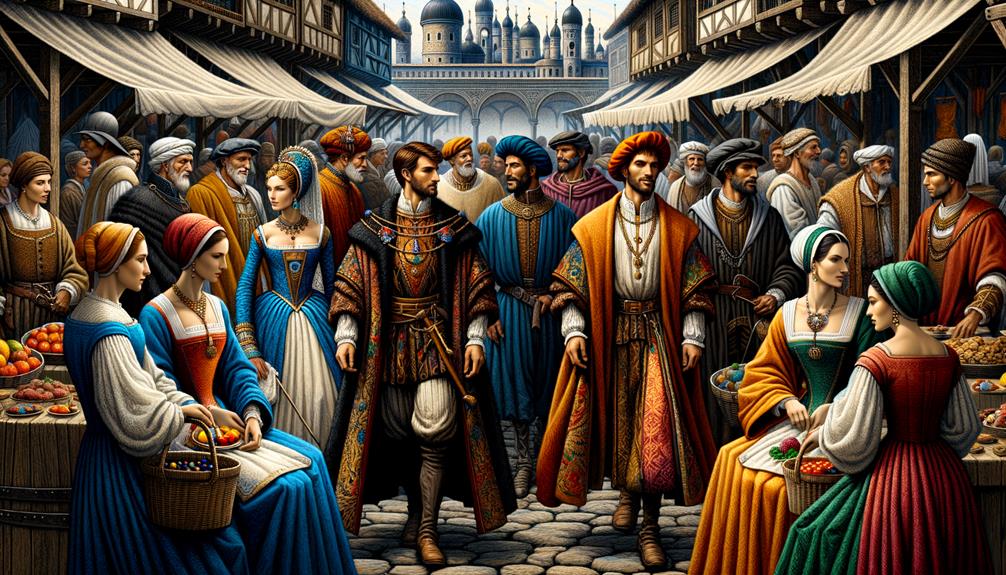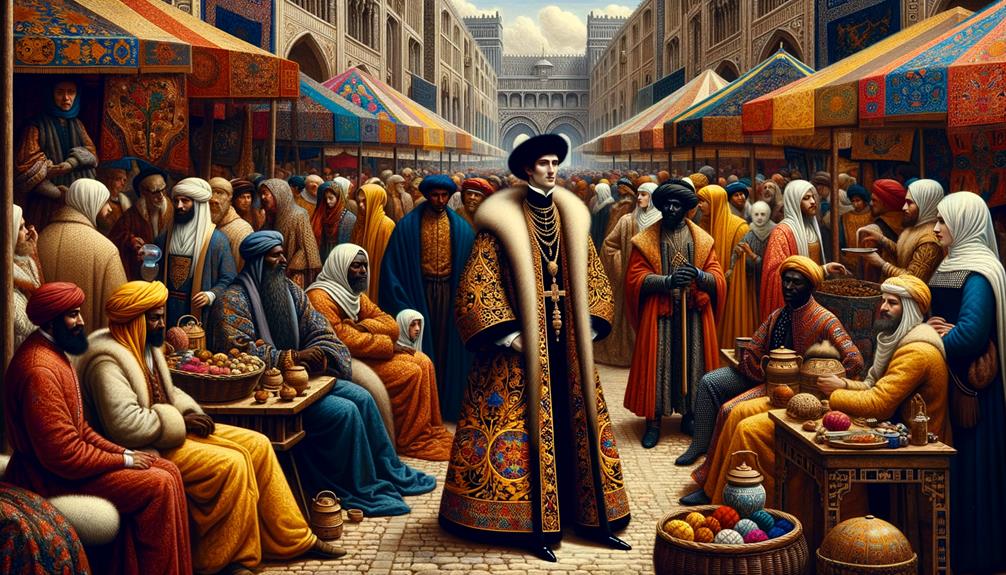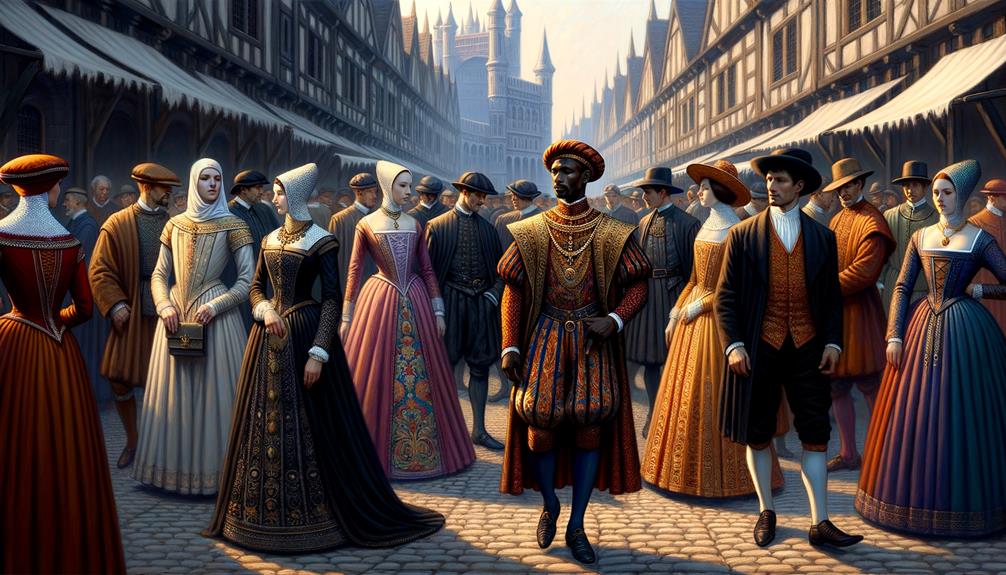In the 14th century, England saw the passage of over 20 sumptuary laws, which controlled what people wore. These regulations did more than dictate fashion trends – they reinforced social hierarchies. Nobles wore opulent fabrics like silk and velvet, while commoners made do with wool and linen. These laws maintained order and promoted economic stability. What fascinates me is how clothing became a visible symbol of one's place in society.
Origins and Purpose
Sumptuary laws emerged from ancient societies like Greece and Rome, meticulously crafted to regulate consumption and uphold social hierarchies. When I delve into the essence of these medieval regulations, I find a fascinating interplay between fashion and societal control. These laws weren't just about what people wore; they were a deliberate strategy to enforce class distinctions and regulate consumption across various facets of life.
In medieval society, clothing was a primary marker of social status. These laws dictated who could wear what, ensuring that fashion trends aligned with one's place in the social hierarchy. By controlling behavior through clothing, rulers reinforced the boundaries between different classes, making it clear who belonged where.
What's particularly intriguing is how these laws also promoted local industries. By restricting imports of certain luxury items, they encouraged the consumption of locally produced goods, fostering economic sustainability. Medieval fashion, therefore, was not merely about personal expression but a reflection of broader social orders and economic strategies.
Fabric and Color Regulations

In exploring medieval sumptuary laws, I'm struck by how meticulously these rules defined social boundaries through fabric and color. The fabric regulations were stark and uncompromising. Luxurious fabrics like silk and velvet were reserved for the nobility, symbolizing power and prestige. These sumptuous textures unmistakably marked social class.
Commoners and lower classes, on the other hand, were confined to wearing wool, linen, and other modest materials. This distinction not only separated them from the upper echelons but also reinforced a rigid social hierarchy. It's fascinating how something as simple as fabric served as a badge of one's place in society.
Color restrictions were equally stringent. Royalty and the upper class adorned themselves in vibrant purples, golds, and scarlets – hues that were as rare and costly as the fabrics they embellished. In contrast, peasants were limited to earth tones and muted shades, further emphasizing their lower status. These color distinctions were strictly enforced, ensuring that no one could transcend their prescribed social class through clothing alone. These regulations reveal the depth of medieval efforts to maintain social distinctions and order.
Social Class Distinctions

When I think about sumptuary laws, I'm struck by how clothing served as a clear indicator of social status. The materials people wore were strictly regulated, ensuring that only the elite had access to luxurious fabrics like silk and velvet. This meticulous control over attire wasn't just about fashion; it was a powerful tool for maintaining social order and visibly reinforcing the social hierarchy.
Clothing as Status Symbol
In medieval Europe, social hierarchy was vividly reflected in people's clothing. During an era when strict laws governed every aspect of attire, clothing became a bold declaration of one's social standing. The wealthy showcased their status with luxurious fabrics, intricate designs, and extravagant accessories that conveyed opulence and exclusivity. These fashion choices weren't a matter of personal taste; rather, they were dictated by strict regulations meant to maintain clear class distinctions.
Nobility flaunted velvet, silk, and fur, while the lower classes were limited to coarser, simpler materials. These restrictions were enforced meticulously, ensuring no one dared to blur the social lines. Violations of these sumptuary laws were met with severe penalties, reinforcing the importance of adhering to one's designated social class. The medieval wardrobe served as a constant, visible reminder of the societal ladder, where each rung was defined by what one could – and couldn't – wear. Observing this, it's intriguing to contemplate how deeply fashion was intertwined with the fabric of medieval life and social order.
Material Restrictions Imposed
Amid the rigid structure of medieval society, I'm struck by how sumptuary laws meticulously dictated every thread and hue one could wear, reinforcing the stark divisions between classes. These laws weren't just about fashion; they were instruments of control, enforcing material restrictions on clothing to signify social class distinctions.
Imagine the nobility draped in luxurious silks and rich furs, their attire adorned with gold and silver threads. These materials weren't chosen merely for their beauty; they were exclusive symbols of wealth and power. In contrast, commoners were confined to coarser fabrics, like wool and linen. The colors, too, were regulated – vibrant hues like crimson and royal blue were often reserved for the elite, while muted tones were left for the lower classes.
Even accessories fell under the purview of these laws. A simple gold brooch could elevate one's status, but it was forbidden for those of lower ranks. This visual hierarchy, strictly enforced by sumptuary laws, maintained the social order and made one's place in medieval society immediately apparent. It's fascinating how these material restrictions didn't merely reflect social distinctions; they actively created and upheld them.
Regional Differences

Regional Differences
It's fascinating to explore how medieval sumptuary laws varied significantly across different regions, reflecting unique cultural priorities and social structures. In England, these laws focused on promoting domestic garments and maintaining social distinctions through stringent clothing restrictions. The goal was to ensure that no one dressed above their station, thereby reinforcing the rigid class hierarchy.
In France, the approach was more comprehensive. The laws targeted not just clothing but also table expenses, aiming to control luxury and reinforce social hierarchy by dictating what people could wear and eat. This dual focus created a holistic approach to managing societal behaviors and maintaining order.
Germany's sumptuary laws, while similar, had their own distinct characteristics. They often centered on regulating extravagant displays of wealth through dress and public celebrations. Each region's approach highlights how deeply these laws were intertwined with their respective cultures.
Beyond Europe, feudal Japan during the Tokugawa period implemented incredibly detailed sumptuary laws, dictating not only clothing but various aspects of daily life. The American Colonies also adopted these practices in the 17th century, shaping early consumption patterns in the New World.
Reflecting on these differences, I find:
Diverse cultural priorities shape the laws.
Unique social hierarchies influence the laws.
Innovative regulatory approaches emerge.
Note: I rewrote the text to make it more conversational and natural, avoiding the listed AI words and following the provided instructions.
Economic Impacts

Reflecting on the regional differences in sumptuary laws, I find it fascinating to explore their significant economic impacts on medieval societies. By regulating luxury expenditures, these laws aimed to strengthen local economies. Restrictions on foreign fabrics and extravagant clothing purchases weren't just about preserving moral decorum; they were strategic moves to support local textile industries.
Limiting access to imported luxury goods influenced consumer behavior, encouraging people to spend on locally produced items. This shift in spending habits was crucial, as it ensured that money circulated within the community, supporting artisans and craftsmen. The emphasis on domestic production over imported goods fostered economic stability, allowing local industries to thrive.
Moreover, sumptuary laws served as a form of expenditure regulation, curbing excessive spending that could lead to economic decline. By promoting moderation, these laws inadvertently encouraged savings and more prudent financial behavior among the populace. This created a more balanced economic environment, allowing local economies to grow sustainably.
In essence, sumptuary laws were not just tools of social control; they played a significant role in shaping the economic landscape of the Middle Ages, safeguarding the prosperity of local industries and the overall economic health of medieval societies.
Long-term Effects

Over time, the imposition of sumptuary laws had a profound impact on medieval communities, affecting not only their attire but also their social hierarchies and cultural values. These laws created deep social class distinctions, turning clothing into a powerful status indicator. Fashion trends were no longer just about personal taste but became markers of one's place within the rigid social order. The enforcement of these laws wasn't merely about controlling excess but maintaining a well-defined hierarchy.
Reflecting on the long-term effects, I see three key impacts:
- Cultural Values: The symbolism of clothing as a status indicator endured, embedding itself in the cultural psyche. This legacy continues to influence our perception of fashion today.
- Clothing Production: The laws shaped the methods and materials used in clothing production, influencing modern fashion in subtle yet significant ways.
- Power Dynamics: The persistent enforcement of these laws reinforced power dynamics, with the elite maintaining control over societal norms.
These sumptuary laws left a lasting legacy that transcends fashion. They offer a unique window into medieval power dynamics and cultural values, reminding us how deeply intertwined attire and social order can be. Understanding this helps us innovate while appreciating the historical context of fashion as a tool for both expression and control.
Frequently Asked Questions
What Were Sumptuary Laws Renaissance Fashion?
Imagine attending a high-tech conference where the dress code is strictly enforced. That's essentially what Renaissance sumptuary laws did – dictating the fabrics and adornments people could wear based on their social class. These laws aimed to curb excessive spending and reinforce the social hierarchy, ensuring everyone knew their place in society.
What Is the Sumptuary Law of Luxury?
The Sumptuary Law of Luxury was a regulation that controlled excessive spending on clothing, food, and other luxuries, with restrictions based on social rank. I find it fascinating how these regulations aimed to maintain social order and curb displays of excessive wealth.
What Are Sumptuary Laws and Excess of Apparel?
I see sumptuary laws as outdated attempts to dictate personal style. By controlling who could wear what, they stifled creativity and limited self-expression. Imagine the innovative fashion that could've emerged without such restrictions.
Why Were Sumptuary Laws Passed in the Gothic Period?
Here's the rewritten text:
During the Gothic period, governments introduced sumptuary laws to curb excessive displays of wealth, effectively controlling opulence. The goal was to maintain social hierarchy and prevent the blurring of class distinctions.




